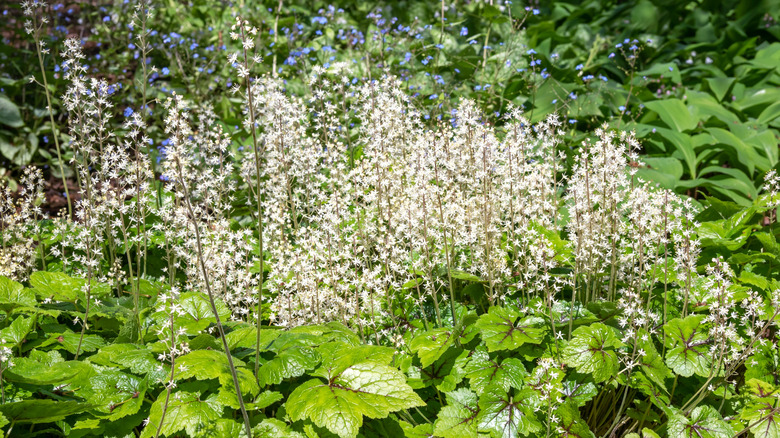Transform A Shade Garden With A Colorful Ground-Covering Flower That Pollinators Love
Sometimes called false miterwort, foamflower (Tiarella cordifolia) is a native wildflower that spreads across woodlands in eastern North America. Small white flowers that seem to float on top of three- to four-inch spikes bloom in the spring and last for four to six weeks, turning your yard into a pollinator garden. Under the right growing conditions, the profusion of flowers looks like a foamy sea, hence the name, transforming the drab ground of a shade garden into a snowy carpet. The semi-evergreen foliage of this herbaceous perennial turns from green to bronze and burgundy in winter.
Thriving in USDA Hardiness Zones 4 through 9, foamflower prefers partial to full shade and rich, well-drained soil. The plant is not drought-resistant and needs regular watering but will develop root rot if the soil remains soggy. In the wild, foamflower grows along streams, forming a soft understory in damp forests. Foamflower grows slowly but spreads by rhizomes, underground roots that send shoots to the surface to create new plants. Eventually, the plants form dense mounded mats that are moderately deer-resistant. Tiarella cordifolia is relatively disease- and pest-free, though snails and slugs can be a problem.
Because of its high tannin content, foamflower has been used for medicinal purposes for centuries. Native Americans valued this property, using the plants as a mouthwash to treat oral sores and thrush, as an astringent in dressings for wounds, and to control diarrhea. Tea brewed from the leaves is reported to be a diuretic and an aid to digestion.
Growing foamflower in your shade garden
Virtually maintenance-free, foamflower grows to about a foot in height, including the flowered spike, making it a good choice for a shade garden with shorter plants at the front and taller flowers, like daylilies, at the back. It's a good companion plant for maidenhair, Christmas and lady ferns, as well as columbine, phlox, hosta, and sedges. The plants thrive in soil rich with organic material and with a neutral to acid pH.
Since these plants suffer in dry conditions, they need to be watered regularly. Consider this clever hose hack in your shade garden, especially if you have chosen other moisture-loving plants to pair with foamflower. Plan for at least an inch of water a week. Verify the depth by digging down into the earth after you've watered and checking to see how deep the water has penetrated the soil. If you're not using soaker hoses, set a cup or can in the garden and irrigate until the container collects an inch of water.
Foamflower should be divided in the spring or fall every one to three years or when the plant shows signs of distress. Propagate foamflower by dividing the mature plant into multiple smaller plants if there are fewer flowers on the adult plant than before, if there's a dead area in the center of the plant, or if the foliage is sparse. Do this by digging up the mature plant, dividing it into smaller plants, and replanting the new sections. This promotes new flowers that attract pollinators and keeps the plants healthy and attractive.

